The Decima MAS, or Decima Flottiglia MAS, was an elite and effective flotilla of the Italian Navy in WWII. It was composed of specially trained frogmen. The unit is also referred to as the X° Mas, 10ª Flottiglia MAS, or Decima Flottiglia MAS. Utilizing Human Torpedos and Explosive Motorboats, these commando frogmen singlehandedly sank or disabled 20 merchant ships, and five warships totaling approximately 224,000 tons.
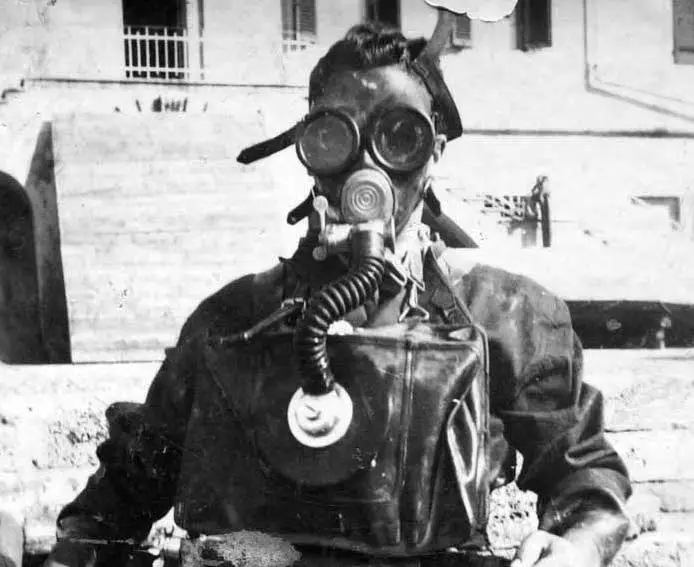
A Decima MAS Frogman.
Origins
During the First World War, the Regia Marina deployed several Motoscafo Armato Silurante (MAS) (Torpedo Motorboats), organized in Flotillas and squadrons patrolling the Adriatic Sea and harassing Austro-Hungarian warships and bases. From their experience with the MAS, the Regia Marina developed an offensive doctrine based on the extensive use of MAS and, to a lesser extent, submarines.

The SMS Viribus Unitis sinking.
This doctrine incorporated a new weapon created towards the end of World War One. In 1918, Engineer Raffaele Rossetti developed the first Human Torpedo (Torpedine Rossetti). The Regia Marina deployed it on 1 November 1918, sinking the Austro-Hungarian battleship Viribus Unitis in Pola harbor. The war ended shortly afterward, and the Torpedine Rossetti became reduced to a bookmark in history for roughly 12 years.
Siluro a Lenta Corsa
In 1930 two engineers of the Livorno Naval Academy, Teseo Tesei and Elios Toschi independently revived the idea and started to improve Rossetti’s weapon. From their work, the Siluro a Lenta Corsa (SLC), or Slow Moving Torpedo, soon came to life.

Teseo Tesei refined the concept of the Human Torpedo.
This new project received little attention until 1935, when the Regia Marina decided to establish a special unit named “1° Flottiglia MAS” (renamed the Decima MAS in March 1941). The new unit incorporated Navy frogmen (known as Gamma men) and Tesei’s group working on the new human torpedo.
In the following years, the SLC became perfected. Additionally, they developed a new weapon, the Motoscafo da Turismo (MT), or Explosive Motorboat. Between 1937 and 1939, Navy leadership’s interest and funding for the Decima Flottiglia MAS had reduced. Therefore, the elite unit was not ultimately battle ready when Italy entered the war in 1940.

Components of the Siluro a Lenta Corsa.
During the beginning of hostilities, the Decima Flottiglia MAS had 11 SLCs and 7 MTs. The submarine Iride, commanded by Tenente di Vascello Francesco Brunetti, was assigned to the Flotilla as a support vessel for the release of SLCs at sea.
The SLC attached externally to the hull of the Iride. However, this system revealed several difficulties when releasing the human torpedo. Two other submarines, Gondar and Scirè, became modified to mount external cylinders containing the SLCs to facilitate the deployment of the frogmen.
Alexandria First Attack
In August 1940, the Regia Marina decided to launch the Decima MAS Human Torpedos against the British Mediterranean fleet anchored in Alexandria. The Regia Marina dispatched submarine Iride to the Gulf of Bomba, west of Tobruk. There, the submarine was to link with the torpedo boat Calipso transporting three Human Torpedoes and their crew, including Teseo Tesei and Toschi.
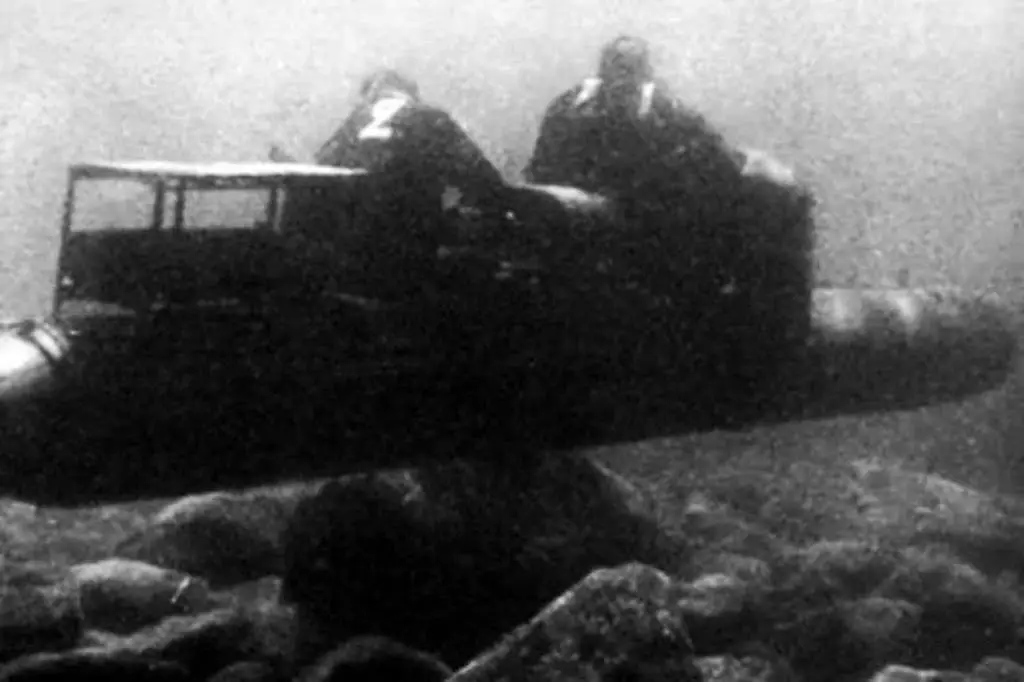
Italian Frogmen of the Decima MAS prepare to strike on a Siluri a Lenta Corsa.
Out of pure luck, British aircraft returning from a bombing mission in Libya noted the Italian presence in the bay. The British ordered further air recognizance, soon followed by an attack by three Swordfish torpedo bombers from HMS Eagle. They managed to sink the Iride, thus putting an end to the operation.
Alexandria Second Attack
A second attempt was made in September of the same year, this time with the Submarine Gondar. However, British destroyers discovered and chased the submarine. Depth charges and bombardment lasting 12 hours forced the Gondar to emerge. After evacuating most of the crew, a few sailors scuttled the submarine. During this action, the British captured Elios Toschi.
Alexandria Third Attack
The third attempted attack against Alexandria occurred in December 1941. However, this attack proved to be highly successful. The submarine Scirè, led by LT Junio Borghese, arrived undetected outside the harbor and released three Human Torpedos. They passed the harbor defenses, exploiting the passage of an enemy ship and approached their targets.
Related: Decima MAS Attack on Alexandria
Lieutenant-Captain Luigi Durand de la Penne and Leading Seaman Emilio Bianchi attacked the Battleship Valliant. Capt. Antonio Marceglia and Leading Seaman Spartaco Schergat attacked the Battleship Queen Elizabeth. Capt. Vincenzo Martellotta and Capt. Mario Marino attacked the Oil tanker Sagona. All three targets sank in the Harbor, but all six became ultimately captured. For their daring raid, they received the Gold Medal for Military Valor. The ceremony was held in Taranto, Italy, in 1945. Former Captain of HMS Valliant, Sir Charles Morgan, personally appointed the medal on De la Penne’s chest.
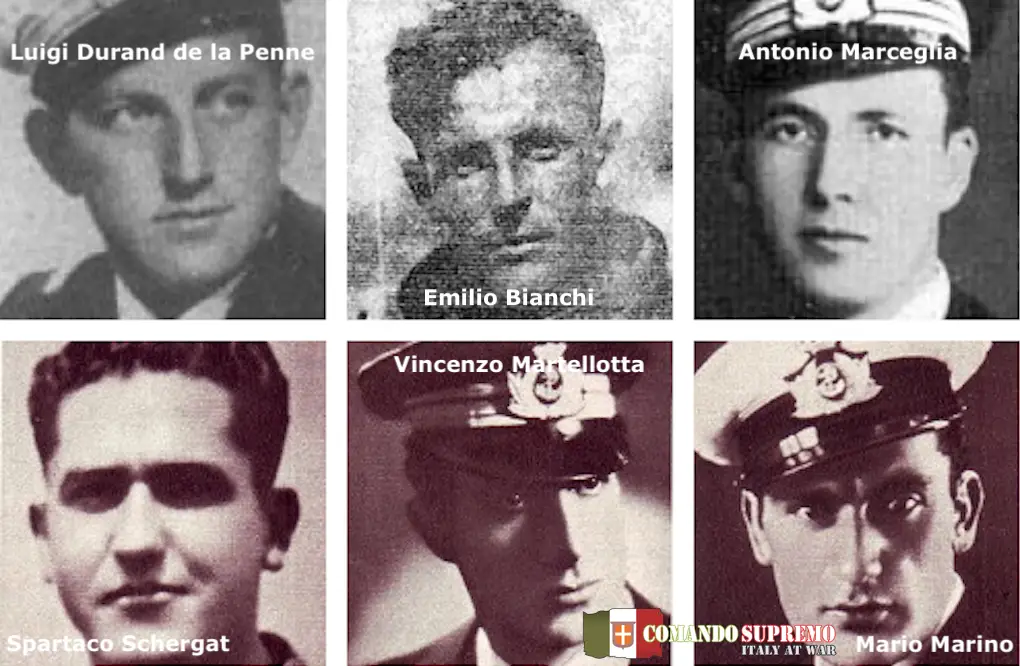
The six frogmen who took part in the Decima MAS attack on Alexandria.
“Six Italians equipped with poor laughable materials, made totter the military balance in the Mediterranean Sea, advantaging the axis.”
Souda Bay
In spring 1941, the British began moving troops and aircraft to Greece. The island of Crete immediately became a strategic location for the Royal Navy. In particular, the Souda Bay was a safe anchorage for warships and merchant ships.
In this context, the Decima Flottiglia MAS planned a new daring raid to attack enemy ships at anchor in the bay. On the night of the 25 March 1941, destroyers Crispi and Sella approached Crete undetected, 10 miles north-east of Souda. There, they released six explosive motorboats (MTM) crewed by Lt. Luigi Faggioni, 2nd Lt. Angelo Cabrini, Alessio De Vito, Tullio Tedeschi, Lino Beccati and Emilio Barbieri.
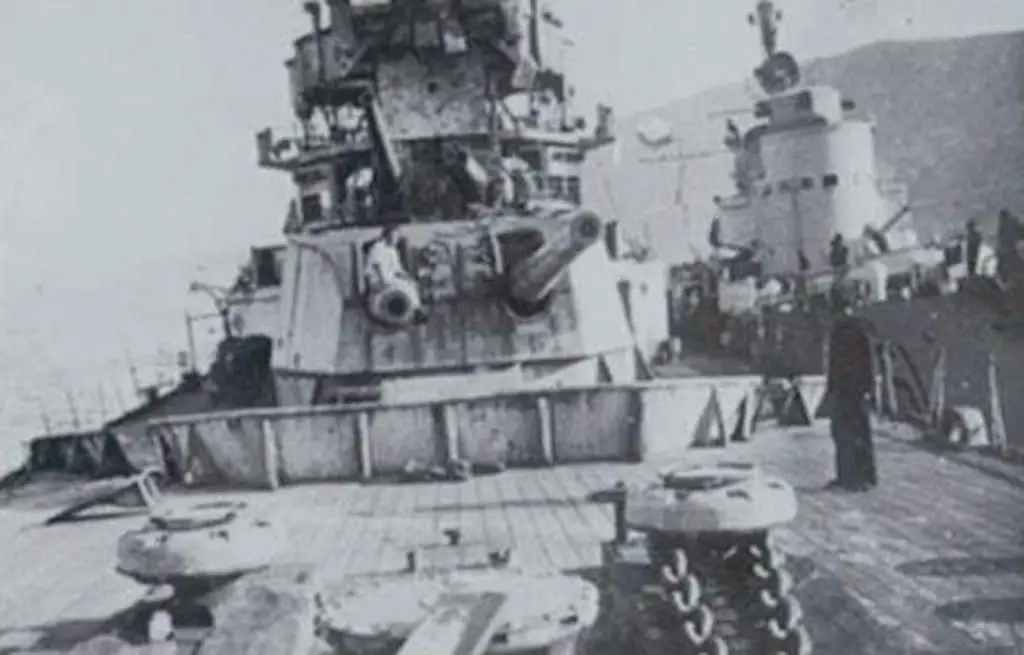
A photo of the crippled HMS York. The Italian torpedo boat Sirio is moored alongside.
They managed to surpass all the obstructions undetected and launched their MTM against their target at anchor. The severely damaged the heavy cruiser HMS York, and it never recovered. They also disabled the oil-tanker Pericles. The six men became captured, but all later awarded the Gold Medal for Military Valor.
Malta
After the success at Souda Bay, the Decima Flottiglia MAS turned its attention to Malta. Captain Vittorio Moccagatta, Commander of the Flotilla, and Major Teseo Tesei prepared an audacious plan to attack and destroy the infrastructure of the Grand Harbor of Valetta. Lt. Borghese opposed the action, claiming it too dangerous and not worthy. In other words, the absence of valuable capital ships in the port was not worth the risk. However, the plan was approved.
The plan went as follows: Tesei, with two SLC, destroy the outer defenses of the harbor. This will allow a group of explosive motorboats to enter the inner harbor and conduct the attack.
On the 23 July 1941, they left Augusta on board the support ship Diana, accompanied by the MAS 451 and MAS 452. After reaching point “K,” the Diana released 8 MTMs and one MTL carrying two Human Torpedos. MAS 451 towed the MTL. In the darkness of the night of 25-26 July, the group of MTMs and the MAS launched the attack.
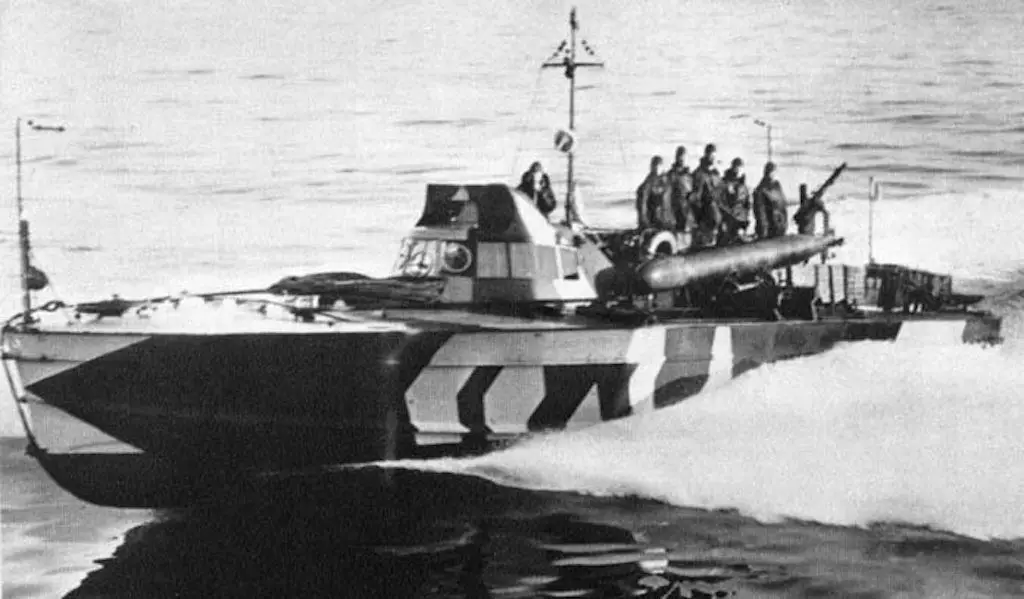
Italian MAS (Motoscafo Armato Silurante)
The daring and incredibly audacious raid resulted in a complete failure. Land-based radar discovered the attacking units and coastal batteries commenced firing as the Italian Frogmen came in. Teseo Tesei and Alcide Pedretti, attempting to buy precious time for the MTM force, sacrificed their lives by immediately detonating the explosive charge of their SLC. The suicide attack was a hopeless attempt to destroy the harbor’s outer defenses for the MTMs.
After the explosion, the MTM group attacked, but coastal battery fire repealed them. Of the 50 men involved in the action, 18 became captured, and 15 killed, including Commander Moccagatta. Capt.
Ernesto Forza succeeded Moccagatta as Commander of the flotilla.
Attacks Against Gibraltar
On the western extreme of the Mediterranean Sea stood the British naval base of Gibraltar. The distance to the “Rock” made it difficult to target with land-based bombers effectively. Therefore, the Regia Marina developed a plan to attack it from the sea using submarines and the SLC.
After three failed attempts in 1940-1941, a new raid was launched in September 1941. In this attack, the submarine Scirè released three SLCs. This time, the British lost 30,000 tons of merchant ships. All the frogmen safely arrived in Spain and repatriated soon afterward.
Raids against enemy ships in the bay of Gibraltar continued. In 1942, a secret base for SLCs became established inside an old Italian 4,995 ton merchant ship named Olterra. The vessel lay interned in the Spanish port of Algeciras, across the b of Gibraltar. Frogmen and SLC raids continued until August 1943, causing the additional loss of roughly 48,000 tons of merchant ships. Through the course of these attacks, Italy shipped replacement torpedos disguised as boiler tubes.
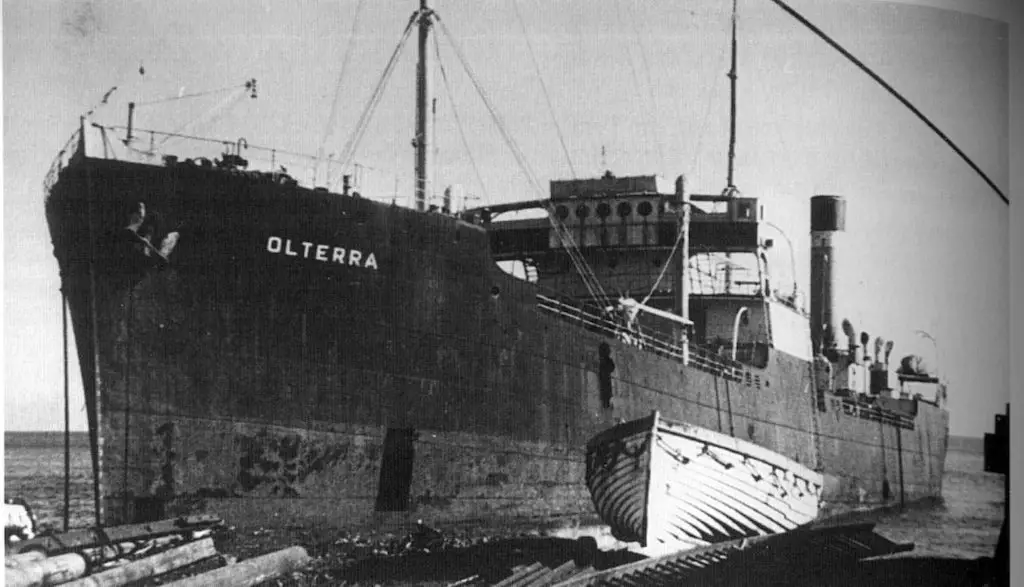
The Olterra.
Meanwhile, the British never discovered the hidden base inside the Olterra, always believing the attacks came from a “mother submarine” at sea.
In May 1943, Commander Junio Valerio Borghese succeeded Ernesto Forza as the head of the Decima Flottiglia MAS.
After the Armistice
As the armistice divided Italy and the armed forces in two, the same happened to the X° Mas. It practically ceased to exist as an operational fighting unit. Ernesto Forza, and officers previously capture by the Allies, such us Durand de La Penne and Marceglia, remained loyal to the King. They formed a new assault unit named “MARIASSALTO” and joined the Allies.
However, Commander Borghese chose to continue fighting alongside the Germans. He formed an elite infantry unit bearing the name “X° Mas.” This unit was one of the few Italian fighting forces employed by the Germans against Allied troops in Italy.
Decima MAS Effectiveness
Reports estimate that during the period 1940-1943, the Regia Marina sank 200,000 tons of warships and 1,000,000 tons of merchant ships. However, the share attributed to the Decima Mas is 38% (76,000 tons in warships) and 15% (148,000 tons in merchants), respectively. These numbers testify to the effectiveness of the tactics and weapons used. However, they suffered a casualty rate of 31%. The X° Mas dispatched a total of 238 men in 38 separate engagements. Of these 238 men, 20 died in action, and 53 taken prisoners.
Related: Mario Arillo: Italian Submarine Commander
Partial Listing of Ships Sunk or Disabled
| Name | Tonnage | Location | Date |
|---|---|---|---|
| Durham | 10,900 | Gibraltar | September 1941 |
| Baron Douglas | 3,900 | Gibraltar | July 1942 |
| Raven's Point | 1,900 | Gibraltar | July 1942 |
| Kaituna | 10,000 | Mersin | July 1943 |
| Meta | 1,600 | Gibraltar | July 1942 |
| Camerata | 4,900 | Gibraltar | May 1943 |
| Stanridge | 6,000 | Gibraltar | August 1943 |
| Queen Elizabeth | 32,000 | Alexandria | December 1941 |
| Valiant | 31,000 | Alexandria | December 1941 |
| Harmattan | 4,600 | Algiers | December 1942 |
| Jervis | 1,700 | Alexandria | December 1941 |
| Mahsud | 7,500 | Gibraltar | May 1943 |
| Fernplant | 7,000 | Iskenderun | August 1943 |
| Empire Centaur | 7,000 | Algiers | December 1942 |
The respect and fear created by the X° Mas is eloquently captured in this quote from Admiral Sir Andrew Cunningham:
Everyone has the jitters, seeing objects swimming about at night, and hearing movements on ships’ bottoms. It must stop!”
Web Sources
Associazione Nazionale Arditi Incursori Marina
Ministero della Difesa
Regia Marina Italiana
M. Gemignani, Teseo Tesei in Dizionario Biografico degli Italiani, TRECCANI, Volume 95 (2019).
S. Setta, Junio Valerio Borghese in Dizionario Biografico degli Italiani, TRECCANI, Volume 34 (1988).